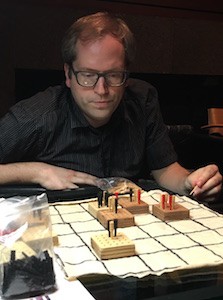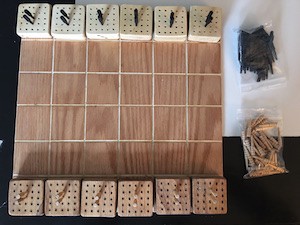My game ideas for the week of 4/29 through 5/5:
4/29 – New Eigenstate game mode, this time with a setup phase before the actual gameplay. I also thought about bringing the pieces back onto the gameboard: musing on “piece in hand” versus “homerow”, in addition to laying out the problem with captures where your opponent gets to then keep some of the pegs for adding the next turn. (Essentially it can lead to a snowball effect.) Also thought about king pieces a bit.
4/30 – A game where you are a leprechaun and you ride cats as your steed. Maybe the premise is that it’s been hard to be a leprechaun since about 1900 or so. Especially with all the new technology, hard to know when to avoid cameras and when you need to stay invisible. You have to collect gold for your pot.
5/1 – A couple of entries on Monday, the first about a game with light-up pieces. This is sort of an aside, but I thought a lot last year at some point about how to package a single LED into a game piece that could also transmit its position through the gameboard to a central controller (as well as be controlled). This would allow you to do cool things like show you all the possible moves when you pick up a piece, or let you play various games against an AI by indicating which piece it wanted to move, and where. Anyway, this particular entry was not about that system, but instead about a thing where each piece looks the same until you hold it under a black light or in some other lighting. The light could be shaped like a dragon’s mouth, and you have to put the stones in the dragon’s breath to tell what you’ve got. It was not really an entire game but more just musing about that single mechanic.
The second entry was more thinking about giving Puzzle Prison some idle game mechanics. Don’t actually think I’ll do this, but I do want to make an idle game at some point soon.
5/2 – Started thinking about using the grid-based piece-movement mechanics that I stole from The Duke and Onitama for Eigenstate — on different grid shapes. I could imagine triangles, or hexes, easy, but what about an irregular grid with different shaped squares? (Like a grid with alternating octogons and squares, for example.) It would necessitate two-sided pieces like The Duke, because whenever a move took you to a space of the other shape, you’d need to re-orient the center (starting) point on the “piece-grid”.
5/3 – Another 2-entry day. The first was inspired by this amazing piece of artwork my kindergartener made, that is basically a drawing of a ladybug with a photograph of her head pasted onto it. I wanted to animate it right away, and maybe make it crawl around on its own. I could definitely imagine a simple platform game for kids with that style of art.
The second entry was about when we will have our first city-scale VR game. We have chair-scale, and room-scale, and I’m imagining being able to walk around the entire city in VR. At that point the line between VR and AR definitely gets blurry, becomes you have issues with avoiding obstacles and stuff like that of course, but if you are not actually viewing reality, it’s still VR, and that’s what I was imagining. Like, when does the tech get so good that it can keep you in the virtual world, but still allow complete freedom of movement.
Later (maybe even that same day), I co-opted the term “City Scale” for a different idea, not really a game, but as a name for a place you can go to work in VR.
5/4 – Thinking about swords in VR, and how in the Ninja Trainer demo, it is annoying that only the front of the blade is “sharp”. You could “fix” this issue by having light sabers, of course, and the more I thought about light sabers in VR, the more I liked the idea. I can easily imagine really enjoying a game like AudioShield, but with sabers instead of shields, and as things fly at you, you have to slice them apart.
5/5 – Very short entry on wanting to manipulate squishy brains in a game. The first idea was a match-3 style game, where you have to drag the brains around, leaving slimy brain-goo trails on the screen.

 This week I managed to spend some time playtesting the board game idea I’d come up with (and been rather cagy about) from 3/28 and 3/30. (Pictured here is
This week I managed to spend some time playtesting the board game idea I’d come up with (and been rather cagy about) from 3/28 and 3/30. (Pictured here is  4/25 – So after making the prototype I mentioned above, I didn’t actually have a chance to play it with anyone right away. It sat on my counter for a while setup as shown in this picture. I spent more time thinking about it and as a result, had this thought: what if it’s actually more of a game system rather than a single game? Right away I came up with two new game ideas. The first is one where each piece starts with a specific number of pegs, say one in each direction, and when it moves that way the peg is removed. In this way, the piece can only move each direction once per game. There are captures, and the player who runs out of moves first loses the game. The second game is a sort of physical version of
4/25 – So after making the prototype I mentioned above, I didn’t actually have a chance to play it with anyone right away. It sat on my counter for a while setup as shown in this picture. I spent more time thinking about it and as a result, had this thought: what if it’s actually more of a game system rather than a single game? Right away I came up with two new game ideas. The first is one where each piece starts with a specific number of pegs, say one in each direction, and when it moves that way the peg is removed. In this way, the piece can only move each direction once per game. There are captures, and the player who runs out of moves first loses the game. The second game is a sort of physical version of